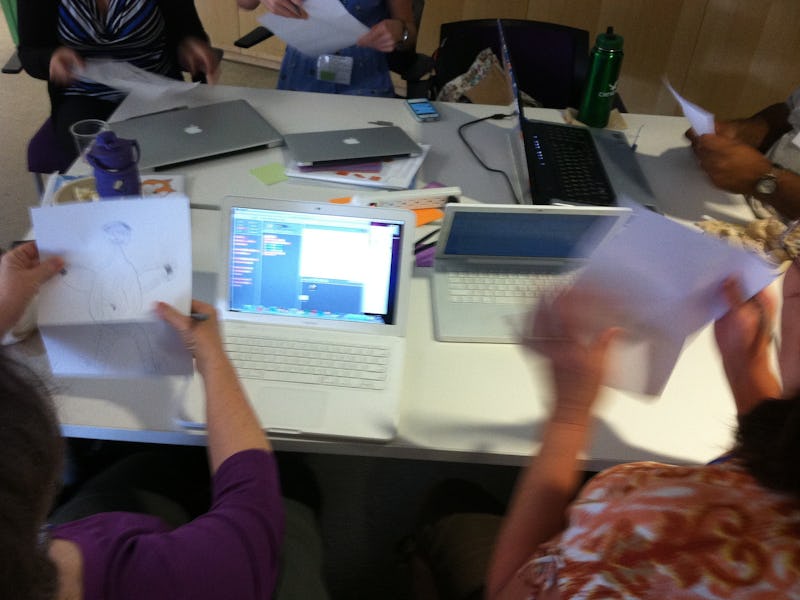Learning to Tell a Story at Tufts | Saturday Syllabi
Take a class without having to go to school.

Telling a story is as old as humankind. We’ve always wanted to relay messages and experiences to each other, whether it was our distant ancestors grunting at each other while hunched over a small fire for warmth or your best friend sitting in a coffee shop sharing a Twitter link. Storytelling is in our blood, and we’ll continue to do so now that the medium seems to be moving away from the printed word towards the digital word. This week’s syllabus from Tufts University seeks to explain how storytelling is changing, but also how it’s enduring.
Class: Digital Storytelling: The Aesthetics and Practices of New Media
Professor: Patrick Johnson
Course Description: “With the proliferation of digital technologies, there has been a dramatic increase in the number of ways individuals can tell their stories and distribute them. Digital comics, blogs, flash-based video games, Twitter feeds, YouTube videos, and audio podcasts have become the new norm for storytelling and personal expression. Digital Storytelling examines these new forms of media from critical, practical, and aesthetic perspectives. Students will examine the aesthetic foundations of “new media,” debate the strengths and weaknesses of each medium, and explore their cultural significance. Additionally, students will engage in multiple storytelling projects over the course of the semester utilizing a variety of media.”
Class Presentations: “Students will give a 7 minute ‘lightning talk’ presentation on a specific story project utilizing new media. The subject of the presentations and the day it is given will be determined by a lottery.”
Final Project: “Students will select a medium of personal interest and write a 10-12 page paper or create their own story utilizing that medium. Detailed instructions will be distributed in class regarding the assignment parameters and expectations per medium. Projects must be approved by instructor.”
Class Schedule Highlights:
Foundations One: Spoken Words and Written Stories:
“What stories are uniquely suited for the print medium? What stories are best told orally? We will examine the form and style of written and oral storytelling and establish a foundation by which we can examine and critique the usage of writing in new media. As an in-class exercise, students will tell stories to their peers and we will examine and discuss their form and structure.”
Required readings for discussion in class:
- King, Steven. On Writing: A Memoir of the Craft. New York: Simon & Schuster, 2000. pp. 111-137
- Woods, James. How Fiction Works. New York: Farrar, Straus and Giroux, 2008. pp. 64-72, 95-107
- Recommended Reading: Campbell, Joseph. The Hero with a Thousand Faces. Princeton, The Princeton University Press, 1973. Print. pp. 30-40
Micro-Writing: Storytelling in the Age of Facebook and Twitter:
“Can sophisticated storytelling take place within 140 characters? What are the strengths of micro-storytelling? We will examine the history of micro-writing from its roots in print to its current state. As an in-class exercise, students will collectively write their own ‘short story’ using Twitter, and examine the benefits and limitations of the form.”
Examples to examine:
- Evan Williams on Listening to Twitter Users
Required readings for discussion in class:
- Raguseo, Carla. “Twitter Fiction: Social Networking and Microfiction in 140 Characters.” TESL-EJ: Teaching English as a Second or Foreign Language, Vol. 13 No. 4 (2010 Mar). Web.
- Wasik, Bill. And Then There’s This; How Stories Live and Die in Viral Culture. New York: Viking Penguin, 2009. Print. pp. 1-15
Audio Only: Podcasts & Musical Storytelling:
“We will examine the form and aesthetics of audio recordings and audio-based storytelling. A brief history of radio and radio-plays. A discussion of storytelling in music and song, particularly in the context of online spaces.”
Examples examined in class:
Required readings for discussion in class:
- Glass, Ira. Radiolab: An Appreciation. Sept. 19th, 2011. Web.
- Kirsner, Scott. Fans Friends and Followers: Building an Audience and a Creative Career in the Digital Age. N.P.: Createspace, 2009. Print. 57-60
Interactive Storytelling: Videogames, Mobile Apps, and Personal Expression:
“Students will engage with independent flash-based videogames and discuss their effectiveness in storytelling. We will also examine and debate the viability for ‘Apps’ to tell stories and the recent cultural trend of ‘gamification.’”
Examples Screened in Class:
- The Great Gatsby, an 8-bit Nintendo-style game
- Jesse Schell’s TED Talk: “When games invade real life”
Required reading for discussion in class:
- Bissell, Tom. Extra Lives: Why Video Games Matter. New York: Pantheon Books, 2010. Print. pp. 33-47
- McGonigal, Jane. Reality Is Broken: Why Games Make Us Better and Can Change The World. New York: Penguin Press HC, 2011. Print. pp. 19-34
With the proliferation of social media, everybody has become a published storyteller in some capacity. This 2012 Tufts class tries to create a semi-taxonomy of the ways in which people are choosing to tell stories away from the tangible page. It also expounds on webpages and blogs, the aesthetics of digital comics, the advancement of the concept of the web series, remix culture, video games as narrative, and more. Do yourself a favor and read the entire syllabus here.
In this class, everyone can find their niche somewhere in the myriad media it covers. The final project: Tell a story in your own way. Which is all any of us are trying to do in the world anyway.